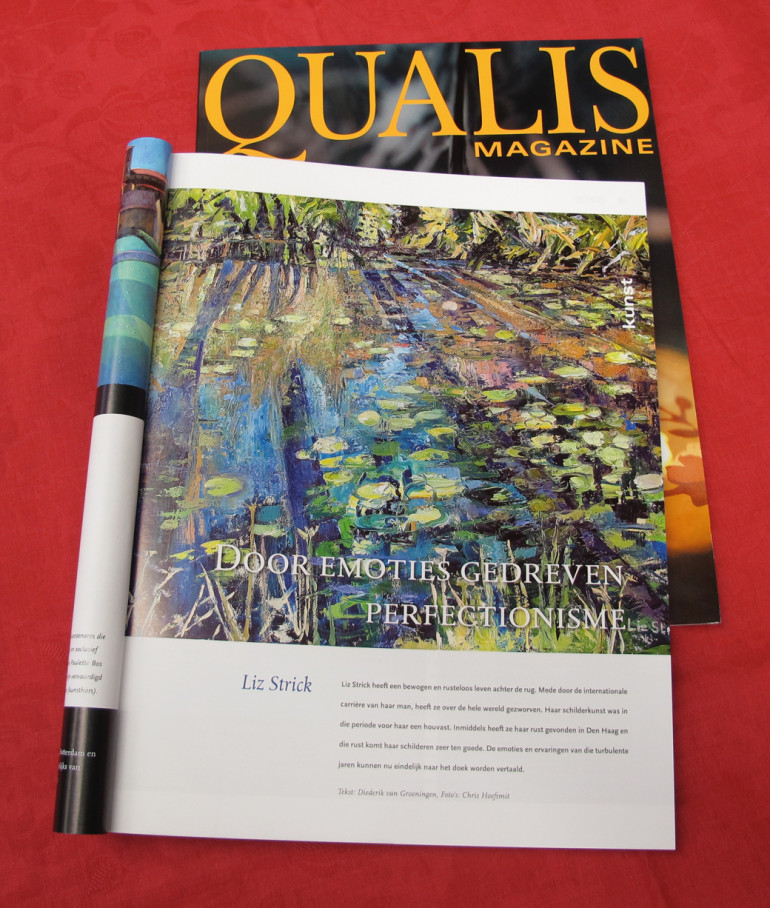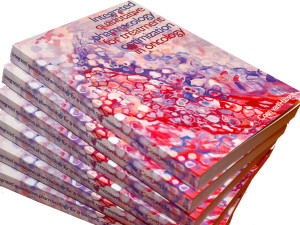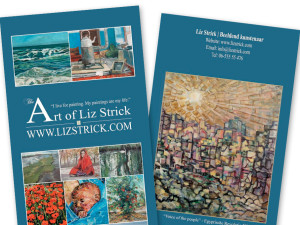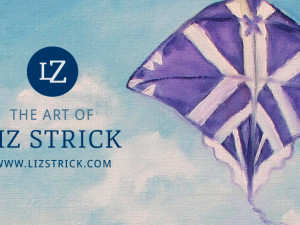
N.B. Voor geïnteresseerden heb ik een aantal gratis exemplaren van het Qualis Magazine klaarliggen.
Perfectionism Driven by Emotions
Liz Strick
Liz Strick has led an unsettled and restless life. Due partly to her husband’s international carreer, she has roamed the globe. During that period, her painting was a source of stability for her. Now she has found peace in The Hague and her painting benefits greatly from it. The emotions and experiences of those turbulent years can now finally be translated onto canvas.
Text: Diederik van Groeningen
Photography: Chris Hoefsmit
“I come from an artistic family. Both my parents were artistically talented and so I grew up with art. After secondary school I studied to become a nurse, and subsequently I worked in Amsterdam for three years. Then I got married. My husband worked for Shell and that meant that we soon left to go abroad. Only to move to yet another country, preferably far away, every three years. Especially when the children were still at home, I didn’t get much chance to paint. At a certain point in time, we decided to send the children to boarding school in England. That was a very tough decision, but the constant moving caused so much turmoil in their lives that we decided to push ahead with this plan. It was only then that I found a degree
of peace and time to focus on painting.” “Colour is a very important element in my work.”
DYNAMICS
“I started painting with water colours, but quickly left that behind me. It is very precise and refined and I just wanted more movement and more dynamics in my paintings. During my stay in Turkey, I came into contact with a Turkish painter named Orhan Taylan and he was actually the one who pointed me in the right direction. That was when I started painting professionally. I had followed all sorts of courses in England, mainly to master the techniques. In the Turkish studio I worked daily with various painters who taught me a lot. I was strongly influenced by Taylan’s expressionist techniques, among others.
After my Turkish period, I lived in many more countries, among which Curaçao, Dubai, England and Germany. It was a tumultuous life, but my painting was my anchor line. In addition, of course, I took in many impressions, which later became valuable in the making of my paintings. It’s as if all those impressions had been saved like a collection of photographs in my memory. And those pictures now and then reappear on canvas, more or less spontaneously, in some form or another. This is certainly noticeable in my use of colour.
Colour is a very important element in my work, all those impressions having contributed in an essential way. It also has to do with my way of working: a lot of my work originates from my innermost feelings. In that sense, painting is an important means of release for me. Through a painting, I can convey things that are hard to put into words.”
INNER STREAM
“I hardly ever know beforehand what I am going to paint, but I do try nowadays to give focus to that inner stream. Otherwise, it becomes difficult to create an integrated set of paintings and that makes exhibiting less easy. That does not mean that I am able to ignore the inner stream. You can tell from many of my paintings, what mood I was in. You simply can’t avoid your own emotions.
And still I find it a wonderful activity. I never start though, before having completed my cardio and power training from 7:00 till 9:30 in the morning. This clears my mind and renews my energy, enabling me to work for hours on end.
My concentration is then at its best for the long day ahead of me. I paint every day and I observe discipline in doing so. On early mornings for example, when I don’t always feel like painting, I still go to my studio and I just see what happens. And more often than not, it turns out that I pick up whatever I was working on very quickly.
That’s why it is so great having my own studio in the house. Sometimes when I get stuck with a painting, I go up in the evenings and peep at it through the stair banister. It’s as if the painting were calling me. I am unable to let it go. In extreme cases I place the painting at the foot of my bed and then when I wake up in the middle of the night, I look at it for a while.
Apparently there is something in the sub-conscious that keeps on about that painting. In most cases, this is the way I find my way in that piece of art.”
COMMERCIAL
“In the past I have painted in many different styles. Pieces from that period are difficult to compare. I only started to give my work more direction last year, partly because you can hardly combine so much variety in a single exhibition. I am no longer guided exclusively by my emotions. Instead I determine a topic beforehand, and approach it from different angles.
“Naturally, I hope that my work will appeal to people. It is necessary if one is to perform this vocation in a professional way. This is why I now also take on commissioned work. People provide me with photographs and I try to approximate their perception. That does not mean that I am not very picky in accepting an order. The chosen subject has to strike a personal chord with me, otherwise I won’t even start. I will not just paint a little house on the Northern Dutch heathlands of Drenthe without feeling that spark. It is a challenge to capture in your own painting the feeling which the client associates with a particular place, person or situation. Still, it has to be entirely “my” painting.
People recognise my paintings by a striking use of colour, the expressive elements which I employ and the feeling I put into it. I also find it very important that the painting as a whole is in balance. People who know me understand the thoughts behind the paintings. There is a certain homogeneous quality to them, no matter how diverse the styles I use. People recognise a ‘Liz Strick’ by a kind of common denominator in my paintings.”
GALLERY OF MY OWN
In 1994 I held my first private exhibition in Turkey and on this occasion, I sold my first pieces. That in itself was remarkable, because people want to get to know you better before they do business with you. The same goes for Kuwait, where I also held an exhibition. People want to build up a kind of personal relationship with you first, and then they are ready to buy. But since my return to the Netherlands, I have found peace here, and actually things are going very well. People come here to look at the paintings and they seem to find them valuable enough to possess. I do need to further develop the commercial side of my
profession by the way. Selling is not my strong point, but it’s part of the game. Honestly, I prefer to spend my time painting. But if you want to move on, you will need to bestow proper attention on this aspect too.
For this reason, I have set up a gallery on the top floor where people can view the paintings at their leisure. Of course, I haven’t been back in the Netherlands that long, so I haven’t yet established the necessary contacts with the galleries. I need to start doing this rather urgently. In the end, it’s a matter of taking the trouble. I am not complaining, by the way, of not having enough publicity. The other day I was asked to create two paintings which were going to be donated to a large campaign by the ICRC (The
International Red Cross) and other aid organisations focusing on themes like ‘human suffering’ and ‘world migration.’ The works of a number of artists will be part of a worldwide campaign, starting in Qatar in December.” “A painting is finished when the composition is balanced.”
BALANCE
“A painting is finished when the composition is balanced. This is a very personal matter, by the way. For me, that moment is attained when I am able to walk past the painting without wanting to add or change anything. Although I have shown people earlier stages of a painting, which they thought were actually better. I am always guided by my own feeling however. Sometimes I face a ‘difficult case’ which I stow away for days, weeks or even months. And then suddenly, I have the solution. The solution always has something to do with the balance in the composition. I also attach high importance to the presentation of my work. In that sense I am somewhat of a perfectionist. But one driven by emotions.”





